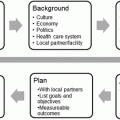Fig. 10.1
GlobeSmart® country profiles. The GlobeSmart® webtool provides a visual representation of some of the key cultural differences that appear in a cross-border collaborative partnership. Some of the gaps along the five cultural dimensions are quite significant and have the potential to impact the success of medical partnerships. Adapted from: What is Global Leadership?: 10 Key Behaviors that Define Great Global Leaders by Ernest Gundling, Terry Hogan and Karen Cvitkovich (Jun 16, 2011)
Independent/Interdependent
The first dimension in this framework is the concept of cultural dependence. This cultural dimension speaks to how individuals define themselves. For example, in independent cultures, the emphasis is on the individual and people tend to define themselves as independent actors, are comfortable standing out from the group, value diverse thought, and make decisions based on what is best for the individual. The ultimate value is placed on individual freedom over group conformity. In contrast, in interdependent cultures, individuals identify themselves more as part of a larger group: a family, a clan, a religious sect, or a team. The individual’s wants or desires are less important and should be sacrificed for the greater good of the group. The emphasis is often maintaining harmony and conforming to fit the broader needs of the group.
In medical partnerships, this dimension can show up in different approaches to medical confidentiality or patient privacy. The concepts of confidentiality and privacy are more rooted in independent cultures, which see the individual as the ultimate agent and owner of information about his or her health. Privacy and confidentiality are often not as strongly rooted or valued in interdependent cultures, where individuals and information about their health are seen as belonging to the family. Families may expect and be given access to patient data, invited into consulting rooms and allowed in treatment areas. Treatment areas may be much more public in interdependent cultures and data may be shared more freely. Decisions about medical treatment are also made very differently as a result of these differences, with families in interdependent cultures making decisions about a patient’s health that would only be made by an individual in a more independent society.
Egalitarian/Status
Status is the cultural dimension which speaks to the differences that exist across cultures in terms of power distance1 or hierarchy. Hierarchical cultures emphasize an individual’s role in society, or in a workplace, and the behaviors appropriate to that role. Each role affords a corresponding level of respect, and individuals must constantly gauge their place relative to the other and modify their behavior accordingly. To enable correct appraisal of a person’s status, hierarchical cultures often rely on many outward symbols of status or rank. In these societies, outward symbolic displays of status, such as accent, title, name card, manners, clothing, and luxury items, become increasingly important as they often determine how one is treated and one’s access to certain privileges.
Egalitarian societies are often very uncomfortable with any power distance and believe that all individuals should be treated with equal respect no matter their title or position in society. These cultures are often uneasy with titles or with any open display of one’s status or wealth.
In a medical collaboration context, gaps along this cultural dimension can appear as different expectations around individual initiative and accountability. Consider the following example:
Following the 2010 earthquake in Haiti, a medical team of radiologists traveled to Haiti in order to train local technologists how to operate newly-donated radiology equipment and increase their capacity to deal with the expanded needs of the population. One of the visiting radiologists from the United States noted the impact of Haiti’s more hierarchical culture on the training environment: “The Haitian technologists seemed so eager to please me, and they would agree with everything I said. I wished that they would ask me more questions, but instead I felt that they would just follow me blindly, even if I was wrong. They seemed to be so dependent on me and didn’t meet me, or what I was telling them, with a critical thinking approach.
Hierarchical or vertical cultures have more centralized decision-making, and subordinates often are not empowered to independently make decisions or solve problems. The ownership for the project or solution often rests solely on the designated leader, and the role of the subordinate is to carry out the leader’s specific instructions without questioning the logic of the approach. Since the leader often controls the information, subordinates do not tend to question or to formulate their own approach to solving an issue. To many of the radiologist volunteer trainers coming from the extremely egalitarian culture of the United States, the behavior of the Haitian technologist trainees was very surprising. Volunteers elaborated on this “high dependency on the top-level person.”
In the US, most technicians, after taking the required pictures, will often take additional pictures in order to be helpful to the radiologist. But here in Haiti, they just do exactly what they are told and do not think to include another picture because they see that the patient is coughing. If they were provided with a piece of equipment and no one came to explain its use, the technicians would not explore the machine to learn how to use it. When we were trying to train the technicians on the anatomy factors that impact a good scan, like, for example, what happens if the patient does not take a deep breath, they were not interested in learning these details, which they perceived to be outside their responsibilities. They just wanted to know the technical tasks they needed to complete. Whether the X-ray was good or bad, this was the doctor’s responsibility.
Direct/Indirect
This cultural dimension addresses how information is communicated. An indirect communication style is often found in hierarchical cultures, where one has to take care how information is conveyed based on the status of one’s counterpart. An indirect communication style places emphasis on how a message is delivered, often more than the actual content of the message itself. The use of silence, nonverbal cues, tone of voice, eye contact, “flowery” speech, and stories is often used to get a point across in a way that will not offend the listener. Direct communicators are often task-oriented and like to get to the point quickly in order to save time and energy, and most importantly, accomplish the goal. They emphasize clarity and believe that being completely transparent shows respect and builds trust with the listener.
Visiting medical teams from more direct cultures sometimes encounter these communication differences in the consulting room. One medical volunteer describes a diagnostic consultation:
When I asked a general question, the patient would tiptoe around the issue. Instead of saying, ‘I have a headache’, he would start telling a long story. In my mind, what was a simple ‘yes’ or ‘no’ answer would take ten minutes to get through. He would actually never say that he had a headache. I was supposed to infer his problem from his long story.
Those involved in international medical work quickly realize the degree to which seemingly objective information is interlinked with cultural nuance and culturally determined patterns of communication. Medical partners from more indirect cultures are often frustrated that seemingly obvious messages are not understood by their more direct counterparts. They are sometimes surprised and offended by the manner in which their more direct partners convey information. In traditionally indirect cultures, such as India and China, it is considered extremely rude to respond to a question with a direct “no,” especially when that response is directed to someone of higher status. Indian and Chinese medical staff often say that, for them, it is almost physically impossible for them to use the word “no” directly. The cultural conditioning against this is just too strong. In order to ensure understanding and clear communication, awareness of these communication differences is critical for cross-cultural medical collaborators.
Stay updated, free articles. Join our Telegram channel

Full access? Get Clinical Tree






